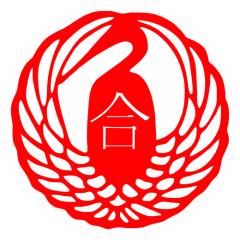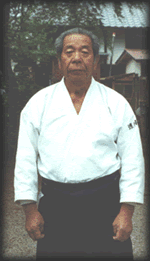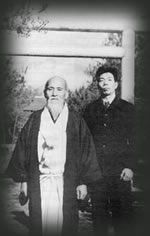Morihiro Saito Sensei died on 5/13/2002 at 02:09 Japanese time. We want to preserve his memory by trying to train and pass on Aikido as he taught us.
Saito Sensei dedicated his whole life to his teacher O-Sensei Morihei Ueshiba. His devotion, personal sacrifice, enthusiasm, and loyalty to O-Sensei cannot be put into words. Saito Sensei’s precise structured analysis, and cataloguing of the founder’s techniques passed on to us cannot be described in words.
TAKEMUSU AIKI/IWAMA RYU=Iwama’s school
An interview with Saito Sensei was conducted by Mats Alexanderson on the day of his 50th aikido anniversary during a seminar in Scandinavia (many thanks for the permission of the publication on my homepage).
MA: Did you practice other Budo arts before your Aikido studies?
Saito: Yes, I studied Kendo, Karate, and some Judo…
MA: How did you first discover Aikido?
Saito: I heard about a mysterious man who taught and developed a completely unknown kind of Budo, not far from where I lived. It was exactly in 1946 when I started training under the founder. When I started with Aikido, the training was incredibly tough and we trained hard. Sometimes we trained Suwari Waza until every single knee bled, but we never stopped training. Sometimes we practiced Suwari Waza for days, then when the founder switched to Ryotedori techniques, we practiced that again for days.
MA: At the time you started Aikido, were there other students in the Dojo?
Saito: Yes, there were other students at that time. Tohei, Abe, Tanabe, and Shioda were there when I started. Tohei only stayed for a short time. He left the dojo because he wanted to start a family. Abe stayed for a year and then went to France. Tanabe stayed for a short time. Shioda only stayed for a short time too. He left the dojo to work in a steel mill, where he later started to teach Aikido.
MA: Besides you, were there any in-home students who were there longer than you? And for how long?
Saito: There were no more house-students! So if you mean house students who stayed longer than a year, many of the students only stayed for three to six months.
MA: Which of the now known Sensei’s (teachers) were the house students?
Saito: So, if you are referring to senseis like Yamada, Tamura, Tohei, Saotome, and Kanai, they were all students of Kisshomaru Ueshiba. They never went to Iwama and studied under or for O-Sensei. Chiba-Sensei only stayed in Iwama for three months.
MA: Who taught in Iwama and Tokyo when O-Sensei was not there?
Saito: When O-Sensei wasn’t in Iwama, I had to stop training. I don’t know who taught in Tokyo since I was in Iwama. I was hardly at the Hombu Dojo. From 1960-61, O-Sensei was very vital. It was then that he went to Tokyo from time to time to teach his art, but then after a few days, students called me to bring O-Sensei back to Iwama. During that time, O-Sensei did not offer anything, he accused them of changing his art.In Iwama, O-Sensei practiced for himself in the early morning hours. I had the opportunity to train with him and in return, worked on his farm.
MA: Where did O-Sensei teach most of the time, In Iwama or Tokyo and how did that change in the 40’s, 50’s and 60’s?
Saito: First I want to clarify that O-Sensei was an Iwama’s person, he wanted to spend his time there. During the 40’s and 50’s, O-Sensei spent most of his time in Iwama, occasionally traveling to Tokyo. In the 1960’s the ratio was about 50/50 and when he no longer wanted to be in Tokyo, he called me…There was always a big difference between what he taught in Tokyo and what he taught in Iwama. O-Sensei did not teach weapons in Hombu Dojo, he just talked about it. The relationship of the RIAI (the connection between Tai-Jutsu and Buki Waza) was taught only in Iwama. O-Sensei trained very hard in Iwama. The development began in 1945 and ended between 1960-65. Aikido was established during this period in Iwama. I was just like to say a few words about this and on the lies about Aikido O-Senseis. For example, there are people who claim that there are no weapons in Aikido. That makes me angry. I want the truth to come to light and the background of Aikido to come to light. Please put this interview on the Internet. I am particularly angry that people often overlook the fact that O-Sensei was a man of Iwama and that Aikido was developed during his time in Iwama.
This is where the interview ended.
Appendix: In 2001 O-Sensei’s grandson, Moriteru Ueshiba, published a text in the AIKI-NEWS/AIKI-Journal that his father Kisshamuru Ueshiba changed O-Sensei’s techniques to make them easier to understand as well as more accessible to the world.
REMARKABLE QUOTES OF MORIHIRO SAITO SENSEI / SHIHAN ( 9 DAN ) R.I.P
1 ) “I don’t know any aikido other than O-Sensei’s.”
2 ) “Many shihan create new techniques and I think this is a wonderful thing, but after analyzing these techniques I am still convinced no one can surpass O-Sensei. I think it is best to follow the forms he left us.These days people are inclined to go their own way, but as long as I am involved, I will continue to do the techniques and forms O-Sensei left us.”
3 ) “It is a big mistake to think that there is no ki no nagare practiced at Iwama. The ki no nagare techniques of Iwama are executed faithfully as O-Sensei taught them. People tend to train in a jerky way. And when people do soft training they do it in a lifeless way. Soft movements should be filled with the strongest “ki.” People can’t grasp the meaning of hard and soft because they didn’t have contact with O-Sensei.”
4 ) “The aikido world is gradually distancing itself from O-Sensei’s techniques. However, if the technique of aikido become weak it’s not a good thing, because aikido is a martial art. My practice of aikido is always traditional, the old-style way. Now I am looking after my Sensei’s dojo. Also, I am guardian of the Aiki Shrine, the only one in the world. Many teachers create their own techniques, but I can’t do that, I’ve got a hard head! I’m following exactly the teachings of my Sensei.”
5 ) “O-Sensei taught us two, three or four levels of techniques. He would begin with kata, then one level after another, and finally, it became just so… and now I teach in exactly the same way. Because O-Sensei taught us systematically I’ve got to teach in an organized way, too. Generally speaking, O-Sensei would make remarks like the following: “Everything is one. Everything is the same.” He taught us in that way. I’m just following his example.”
6 ) “When O-Sensei explained Aikido he always said that taijutsu (body techniques) and ken and jo techniques were all the same. He always started out his explanation of Aikido using the ken. Although he didn’t use a one-two-three method, he always taught us patiently and explained in detail what we should do.”
7 ) “O-Sensei also drilled us in a step-by-step manner. I am simply trying to make this method my own through hard study and to have others understand it. As I follow O-Sensei’s instructions my students are appreciative.”
9 ) “O-Sensei would say: “That’s not the way. Every little detail should be correct. Otherwise, it isn’t a technique. See, like this… like that!” I was very lucky O-Sensei taught me thoroughly in detail, and I’m following his example.”
10 ) “When I starting teaching myself I realized O-Sensei’s way of teaching would not be appropriate so I classified and arranged his jo techniques. I rearranged everything into 20 basic movements I called “suburi” which included tsuki (thrusting), uchikomi (striking), hassogaeshi (figure-eight movements), and so on so it would be easier for students to practice them.I was taught first how to swing a sword. I organized what I learned and devised these kumijo and suburi for the sword. O-Sensei’s method may have been good for private lessons, but not for teaching groups. In his method, there were no names for techniques, no words. This was why I organized the movements into tsuki (thrusts), uchikomi (strikes) and kaeshi (turning movements) and gave them names.”
11 ) “I saw nothing but the real thing for 23 years. I don’t really know anything other than the Iwama style taught by O-Sensei. My role is to preserve these teachings. That’s the main thing.”



